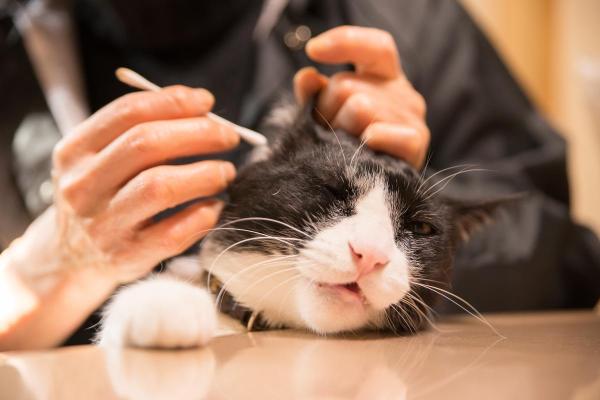Black Wax in a Cat's Ears - Causes and Treatment



See files for Cats
Black wax in a cat's ear is due to the natural secretions being mixed with another substance. The wax itself won't be black, but these other substances cause the discoloration. Identifying the substance will help us to identify the underlying problem. There are certain pathologies and conditions to which cats are specifically prone that can result in a darkening of their ear wax. These can be anything from parasites to tumors of the ear. Despite the varying severity of these problems, none of them can be ignored. Doing so can cause harm to the cat's ear, potentially resulting in deafness or even worse health repercussions.
At AnimalWised, we explain the causes and treatment of black wax in a cat's ear. Whatever the underlying cause, it is vital we go to the veterinarian for diagnosis as they will be the only one qualified to treat the issue.
Ear mites
Ear mites are not only one of the most common causes of black wax in a cat's ears, but they are one of the most frequent health problems in cats. Despite their feline devotion to hygiene, cats are prone to ear mites. This is partly because the ear canal is one of the most difficult places for them to clean themselves. The mite that most commonly parasitizes the ear of cats is the species Otodectes cynotis, resulting in a condition known as otoacariasis.
The presence of Otodectes in the ear canal of cats causes a series of symptoms. The most striking is the appearance of a brownish-blackish discharge. This can be invariably dry or pasty, depending on the levels of earwax, blood and exudates from the mites.
It is not black wax which is likely the first sign which indicates ear mites in cats. It is usually when a cat keeps scratching their ears that we realize there is a problem. They do this because of the irritation the mites cause to the sensitive area of skin. They may also shake their heads to relieve the irritation. Scratching can result in wounds with potential complications such as infections and aural hematomas in cats.
The diagnosis of otoacariasis is usually straightforward. By exploring the ear canal with an otoscope, the mites can be visualized. This may not be enough to determine the species of mite, so a sample of the exudate can be taken for microscopic analysis.
Once the particular mite has been identified, treatment of ear mites in cats can involve:
- Cleaning the external ear: the inside of the cat's ear can be cleaned with a gauze soaked in saline or chlorhexidine diluted to 40%. In addition to cleaning the pinna, the external ear canal should also be cleaned to ensure the deworming treatment penetrates adequately. We can only use products which are specially formulated for cleaning a cat's ears, otherwise we can worsen the clinical picture.
- Antiparasitic treatment: to end the infestation of the mites, the correct antiparasitic treatment must be administered. It is for this reason that we must go to the veterinarian as they will be the one who can identify the correct mite. These drugs include fipronil for cats administered as ear drops or topical treatment such as selamectin.
Fungal otitis
Another common cause of black stuff in a cat's ear is a fungal infection. This is usually in the form of yeasts such as those from the genus Malassezia. While these yeasts are part of the normal microbiota of the cat's ear canal, an overproliferation can cause infection leading to inflammation of the ear known as otitis in cats.
While it is the increased amount of fungi that results in the otitis, the underlying cause of the fungal overproliferation can be varied. Such causes include increased humidity in the home, pH changes to the cat's skin, allergies, foreign bodies or even the aforementioned otoacariasis.
Cats suffering from yeast otitis have a pasty, brownish-colored cerumen with a strong odor. Cerumen is the scientific term for earwax, so it appears as if the cat has black wax in their ears. Unlike otitis caused by mites, there is usually not such an intense itching sensation.
The treatment of this type of otitis requires:
- Cleaning the ear canal: as we have already mentioned, the inside of the ear pinna can be cleaned with a gauze impregnated with saline solution or diluted chlorhexidine. Cleaning the ear canal requires the use of products specially designed for cleaning the ears of cats.
- Antifungal treatment: it will be the veterinarian who will determine which drug is the most appropriate for your cat's fungal infection. One common treatment is providing drugs such as itraconazole for cats at a dose of 10 mg/kg/day until the infection subsides.

Tumors
There are two main types of tumors that can cause the appearance of a blackish wax in a cat's ear. These are ceruminous gland adenoma and adenocarcinoma. Both are types of tumors that affect the ceruminous glands present in the ear canal:
- Ceruminous gland adenoma: the adenoma is a benign tumor that mainly affects elderly cats. Adenomas are usually nodules or pedunculated masses that rarely ulcerate.
- Adenocarcinoma: a malignant tumor that is usually locally invasive. It frequently metastasizes to regional lymph nodes and the parotid gland. They usually present in the form of ulcerated, irregular masses with a friable appearance. Like adenomas, they usually affect older animals.
In both cases, it is common for an oily, blackish-brown discharge to be produced which drains through the ear canal. The presence of these tumors in the ear canal usually causes discomfort and itching, so it is common to see cats shake their heads and scratch their ears.
The treatment of these two types of tumors is surgical:
- In the case of the adenoma, a conservative excision should be performed. The prognosis is good.
- In the case of adenocarcinoma, a more aggressive surgery must be performed. in some cases it may be advisable to start chemotherapy or radiotherapy treatment after surgery.
These types of tumors are not only limited to the ear area. Learn about how these can affect other part's of the cat's organism with our article on intestinal adenocarcinoma in cats.

Lack of hygiene
In small animal clinics, it is common for cat guardians to state a consultation claiming that their cat's ears are very dirty. In these cases, the problem is usually due to inadequate ear hygiene on the part of the guardian themselves.
A cat's ears should be cleaned approximately every two weeks. This cleaning should cover the inside of the auricular pavilion of the ear, as well as the outside of the auditory canal. When this cleaning is not performed preventively, it is common for the earwax to acquire a dark or even black color over time. This is due to the collection of residue in the form of dirt, cell debris and other material which oxidizes when coming in contact with air.
In these cases, the presence of dark earwax does not have a pathological significance in itself, but poor hygiene can predispose the cat to future problems such as otitis. Not cleaning the cat's earwax may also result in hearing loss due to damage to the ear's sensitive parts. That is why it is essential to maintain correct hygiene of cat's ears by carrying out preventive cleanings on a regular basis.

This article is purely informative. AnimalWised does not have the authority to prescribe any veterinary treatment or create a diagnosis. We invite you to take your pet to the veterinarian if they are suffering from any condition or pain.
If you want to read similar articles to Black Wax in a Cat's Ears - Causes and Treatment, we recommend you visit our Other health problems category.







